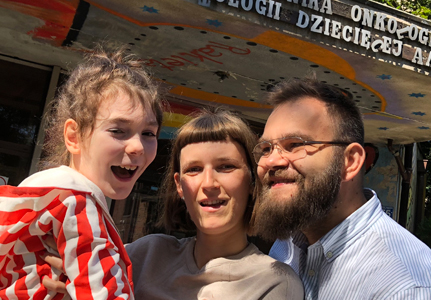Borys’ story: Living with metachromatic leukodystrophy
October 2018
This is the story of Borys the Hero, who just like any other hero has his own Deadly Enemy.
In 2014, Borys was diagnosed with an incurable genetic disease called metachromatic leukodystrophy (MLD). MLD is a rare disease that belongs to the group of lysosomal storage diseases, and which leads to progressive deterioration of motor and neurocognitive function.
As a result of an error in one of the genes, the body does not produce a specific enzyme (arylsulfatase A – ARSA), resulting in an excessive accumulation of a non-removable lipid called sulfatase. After a few years, the child experiences gradual disappearance of some of the functions of the whole body, and in general starts to lose development skills. At first there are problems with motor skills, then speech fades, then the child loses the ability to hear, see, eat and breathe, all leading up to premature death.
Borys’ journey to diagnosis and treatment
“When Borys was a baby we did not see any clear symptoms predicting future diagnosis”, says Kasia, Borys’ mum. “In 2012, when he was three years old, he had a gallbladder inflammation, which now we identify as a clear signal of forthcoming diagnosis. Then when he was five years old, he started to have some problems with physical activities such as drawing and writing. We went to see developmental neurologist who told us that Borys was a big and clumsy boy, but without any major symptoms.”
She continues, “At the age of 5 and a half years old he started tiptoeing and this was a signal to get a second opinion from a developmental neurologist. We then met Professor Maria Mazurkiewicz-Bełdzińska, a developmental neurologist from the University Clinical Centre of Medical University of Gdańsk, Poland, who diagnosed Borys with MLD. She was the first beacon of light on our forthcoming journey … and the Hero was born.”
The disease is incurable. There are some clinical trials running around the world (Hong Kong, Milan, Paris), the results from which are promising, but for the moment these procedures are not accessible to all.
Right now, the most common treatment of MLD is bone marrow or hematopoietic stem cell transplant. Thanks to the knowledge and courage of the doctors at the Transplant Clinic of Wroclaw, especially Professor Krzysztof Kałwak – the family’s second beacon of light – Borys had his stem cell transplant in 2015, one of the first procedures of this type in Poland.
Borys the Hero
Borys’ dad Tomasz says, “Why do we call him Borys the Hero? Because he is a real Hero who fights bravely against his deadly enemy every day. He does not give up and does not lose hope. His heroism infects others and motivates them to keep on fighting. But at the same time he is a naughty scamp who has normal problems, such as whether Mary still likes him, whether Michael will return quickly after being sick, or if the snow will be good for making a snowman”.
“Our journey for life for Borys has led us across two continents, three countries and clinical centers (Milan, Paris, Pittsburgh) and took us almost a year from diagnosis to treatment. The Enemy won plenty of battles in Borys’ body, but we have saved his soul and mind. Now we focus on development of his motor & cognitive skills through home schooling, integration classes and projects with his healthy classmates, supported by augmentative and alternative communications methods, as well as physical physiotherapies (NDT Bobath, Vojta, P-DTR, CST). At the same time, we encourage his passions of swimming, reading books and listening to jazz music… simply just to implement his Plan for LIFE!”
Visit the Borys the Hero website or Facebook group.
Metachromatic leukodystrophy patient organisations
Find support via MLD patient organisations:
Eva Bearryman, Communications Manager, EURORDIS
